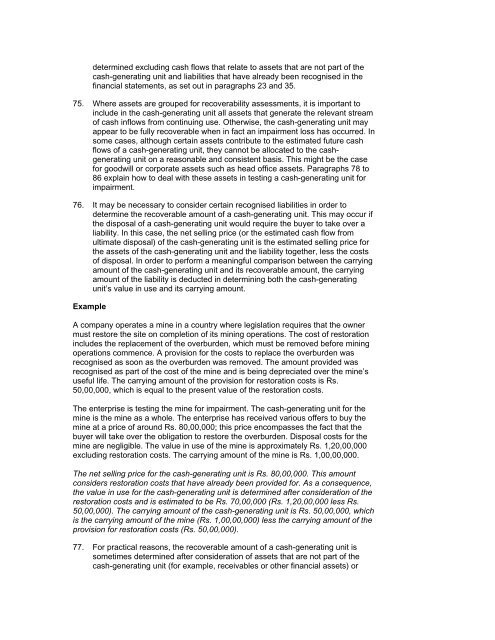Accounting Standards 1-29 - Seth & Associates
Accounting Standards 1-29 - Seth & Associates
Accounting Standards 1-29 - Seth & Associates
You also want an ePaper? Increase the reach of your titles
YUMPU automatically turns print PDFs into web optimized ePapers that Google loves.
determined excluding cash flows that relate to assets that are not part of the<br />
cash-generating unit and liabilities that have already been recognised in the<br />
financial statements, as set out in paragraphs 23 and 35.<br />
75. Where assets are grouped for recoverability assessments, it is important to<br />
include in the cash-generating unit all assets that generate the relevant stream<br />
of cash inflows from continuing use. Otherwise, the cash-generating unit may<br />
appear to be fully recoverable when in fact an impairment loss has occurred. In<br />
some cases, although certain assets contribute to the estimated future cash<br />
flows of a cash-generating unit, they cannot be allocated to the cashgenerating<br />
unit on a reasonable and consistent basis. This might be the case<br />
for goodwill or corporate assets such as head office assets. Paragraphs 78 to<br />
86 explain how to deal with these assets in testing a cash-generating unit for<br />
impairment.<br />
76. It may be necessary to consider certain recognised liabilities in order to<br />
determine the recoverable amount of a cash-generating unit. This may occur if<br />
the disposal of a cash-generating unit would require the buyer to take over a<br />
liability. In this case, the net selling price (or the estimated cash flow from<br />
ultimate disposal) of the cash-generating unit is the estimated selling price for<br />
the assets of the cash-generating unit and the liability together, less the costs<br />
of disposal. In order to perform a meaningful comparison between the carrying<br />
amount of the cash-generating unit and its recoverable amount, the carrying<br />
amount of the liability is deducted in determining both the cash-generating<br />
unit’s value in use and its carrying amount.<br />
Example<br />
A company operates a mine in a country where legislation requires that the owner<br />
must restore the site on completion of its mining operations. The cost of restoration<br />
includes the replacement of the overburden, which must be removed before mining<br />
operations commence. A provision for the costs to replace the overburden was<br />
recognised as soon as the overburden was removed. The amount provided was<br />
recognised as part of the cost of the mine and is being depreciated over the mine’s<br />
useful life. The carrying amount of the provision for restoration costs is Rs.<br />
50,00,000, which is equal to the present value of the restoration costs.<br />
The enterprise is testing the mine for impairment. The cash-generating unit for the<br />
mine is the mine as a whole. The enterprise has received various offers to buy the<br />
mine at a price of around Rs. 80,00,000; this price encompasses the fact that the<br />
buyer will take over the obligation to restore the overburden. Disposal costs for the<br />
mine are negligible. The value in use of the mine is approximately Rs. 1,20,00,000<br />
excluding restoration costs. The carrying amount of the mine is Rs. 1,00,00,000.<br />
The net selling price for the cash-generating unit is Rs. 80,00,000. This amount<br />
considers restoration costs that have already been provided for. As a consequence,<br />
the value in use for the cash-generating unit is determined after consideration of the<br />
restoration costs and is estimated to be Rs. 70,00,000 (Rs. 1,20,00,000 less Rs.<br />
50,00,000). The carrying amount of the cash-generating unit is Rs. 50,00,000, which<br />
is the carrying amount of the mine (Rs. 1,00,00,000) less the carrying amount of the<br />
provision for restoration costs (Rs. 50,00,000).<br />
77. For practical reasons, the recoverable amount of a cash-generating unit is<br />
sometimes determined after consideration of assets that are not part of the<br />
cash-generating unit (for example, receivables or other financial assets) or




